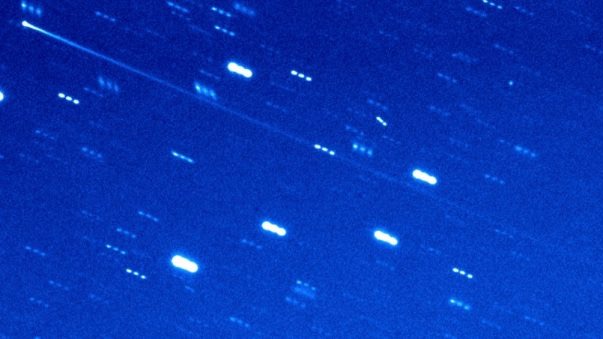
Comet or asteroid?
If you saw an object in the asteroid belt with a long comet-like tail, what would you call it? A comet or an asteroid? Or perhaps a cometoid (meaning comet-like)? Scientists from the Planetary Science Institute announced on October 4, 2021, that a comet-like object in the asteroid belt that they’ve been studying is a rare type that transcends easy labeling. This object – designated (248370) 2005 QN173 – is the eighth active asteroid found, out of more than half a million known main-belt asteroids. Scientists are listing it as one of about 20 known main-belt comets.
Lead author Henry Hsieh from the Planetary Science Institute presented this study at a press conference on October 4, at the 53rd annual meeting (in this case, a virtual meeting) of the American Astronomical Society’s Division for Planetary Sciences. The paper is accepted for publication in the peer-reviewed Astrophysical Journal Letters.
A main-belt comet
On July 7, 2021, the Asteroid Terrestrial-impact Last Alert System (ATLAS) survey witnessed activity on (248370) 2005 QN137. And this was not the only time the object was active. As Hsieh said:
This behavior strongly indicates that its activity is due to the sublimation [process of changing from a solid to a gas] of icy material. As such, it’s considered a main-belt comet, and is one of just about 20 objects that have currently been confirmed or are suspected to be main-belt comets, including some that have only been observed to be active once so far.
Main-belt comets are asteroids that present characteristics of comets. That is, they are icy and, when warmed by the sun, they release some of their material into space. The material then flows behind in comet-like tails. Hsieh explained:
[Object] 248370 can be thought of as both an asteroid and a comet, or more specifically, a main-belt asteroid that has just recently been recognized to also be a comet. It fits the physical definitions of a comet, in that it is likely icy and is ejecting dust into space, even though it also has the orbit of an asteroid. This duality and blurring of the boundary between what were previously thought to be two completely separate types of objects – asteroids and comets – is a key part of what makes these objects so interesting.

Analyzing (248370) 2005 QN137
The July 2021 observations revealed the nucleus, or head, of the main-belt comet enveloped in a dust cloud. The dust cloud is 2 miles (3.2 km) across. The tail was more than 450,000 miles (720,000 km) long. This is the same as the distance between the Earth and the moon times three. Yet the tail was rather skinny, at just 900 miles (1,400 km) wide. For comparison, if the comet (including its tail) were scaled to the length of a football field, the tail would be 7 inches wide and the nucleus would span half a millimeter across. Hsieh explained what these measurements mean:
This extremely narrow tail tells us that dust particles are barely floating off of the nucleus at extremely slow speeds and that the flow of gas escaping from the comet that normally lifts dust off into space from a comet is extremely weak. Such slow speeds would normally make it difficult for dust to escape from the gravity of the nucleus itself, so this suggests that something else might be helping the dust to escape. For example, the nucleus might be spinning fast enough that it’s helping to fling dust off into space that has been partially lifted by escaping gas. Further observations will be needed to confirm the rotation speed of the nucleus though.
Hsieh continued:
Cometary activity is generally thought to be caused by sublimation – the transformation from ice to gas – of icy material in a solar system object, which means that most comets are found to come from the cold outer solar system, beyond the orbit of Neptune, and spend most of their time there, with their highly elongated orbits only bringing them close to the sun and the Earth for short periods at a time. During those times when they are close enough to the sun, they heat up and release gas and dust as a result of ice sublimation, producing the fuzzy appearance and often spectacular tails associated with comets.
Comet or asteroid in the history of the solar system
Scientists believe that objects in the asteroid belt have been there since the formation of the solar system some 4.6 billion years ago. They further believed that any ice in these objects should have dissipated long ago. Yet these few rare objects, the main-belt comets, appear to defy these rules. Hsieh and David Jewitt discovered the first such creature in 2006.
Main-belt comets are an interesting target of study, because scientists believe that much of Earth’s water came from asteroid impacts during the early years of the solar system’s formation. Finding objects in the asteroid belt that still contain ice provides a testing ground for learning more about the origin of life on Earth.

Bottom line: Comet or asteroid? How about both? Some objects in astronomy blur the lines between neat categorizations. The object (248370) 2005 QN173 is active with a long tail but resides in the asteroid belt.
Source: Physical Characterization of Main-Belt Comet (248370) 2005 QN173











